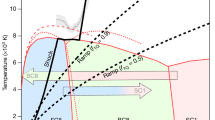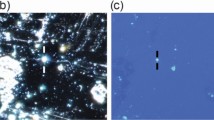Abstract
SPHERICAL particles of carbon consisting of concentric graphite-like shells ('carbon onions') can be formed by electron irradiation of graphitic carbon materials1,2. Here we report that, when such particles are heated to ∼700 °C and irradiated with electrons, their cores can be transformed to diamond. Under these conditions the spacing between layers in the carbon onions decreases from 0.31 in the outer shells (slightly less than the 0.34-nm layer spacing of graphite) to about 0.22 nm in the core, indicating considerable compression towards the particle centres. We find that this compression allows diamond to nucleate—in effect the carbon onions act as nanoscopic pressure cells for diamond formation.
This is a preview of subscription content, access via your institution
Access options
Subscribe to this journal
Receive 51 print issues and online access
$199.00 per year
only $3.90 per issue
Buy this article
- Purchase on Springer Link
- Instant access to full article PDF
Prices may be subject to local taxes which are calculated during checkout
Similar content being viewed by others
References
Kroto, H. W. Nature 359, 670–671 (1992).
Ugarte, D. Nature 359, 707–709 (1992).
Banhart, F., Ajayan, P. M., Redlich, Ph. & Füller, T. Phys. Rev. Lett. (submitted).
Höschen, R., Sigle, W. & Phillipp, F. in Proc. llth European Congress on Microscopy (in the press).
Ebbesen, T. W. & Ajayan, P. M. Nature 358, 220–222 (1992).
Lynch, R. W. & Drickamer, H. G. J. chem. Phys. 44, 181–184 (1966).
Ruoff, R. S. & Ruoff, A. L. Nature 350, 663–664 (1991).
Bacon, R. J. appl. Phys. 31, 283–290 (1960).
Sandré, E., Julien, J.-P. & Cyrot-Lackmann, F. J. Phys. Chem. Solids 55, 1261–1268 (1994).
De Vita, A., Galli, G., Canning, A. & Car, R. Nature 379, 523–526 (1996).
Bar-Yam, Y. & Moustakas, T. D. Nature 342, 786–787 (1989).
Clarke, R. & Uher, C. Adv. Phys. 33, 469–566 (1984).
Angus, J. C. & Hayman, C. C. Science 241, 913–921 (1988).
Bundy, F. P. Physica A156, 169–178 (1989).
Lambrecht, W. R. L. et al. Nature 364, 607–610 (1993).
Núñez Regueiro, M., Monceau, P. & Hodeau, J.-L. Nature 355, 237–239 (1992).
Ruoff, R. S., Lorents, D. C., Chan, B., Malhotra, R. & Subramoney, S. Science 259, 346–347 (1993).
Author information
Authors and Affiliations
Rights and permissions
About this article
Cite this article
Banhart, F., Ajayan, P. Carbon onions as nanoscopic pressure cells for diamond formation. Nature 382, 433–435 (1996). https://doi.org/10.1038/382433a0
Received:
Accepted:
Issue Date:
DOI: https://doi.org/10.1038/382433a0
This article is cited by
-
Effect of catalyst type on the type and size of nano-diamond synthesized by chlorine gas etching of Ti3C2 MXene under ambient pressure
Journal of Materials Science (2024)
-
Ambient synthesis of diamond in saline alcohol
Carbon Letters (2024)
-
Preservation of high-pressure volatiles in nanostructured diamond capsules
Nature (2022)
-
Realization of diamond nucleation within the multi-walled carbon nanotubes matrix upon electron irradiation
Carbon Letters (2022)
-
Formation of large area closely packed carbon onions film by plasma-based ion implantation
Scientific Reports (2020)
Comments
By submitting a comment you agree to abide by our Terms and Community Guidelines. If you find something abusive or that does not comply with our terms or guidelines please flag it as inappropriate.



